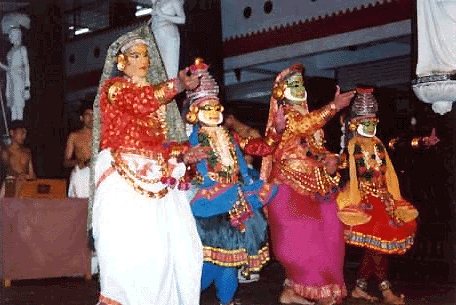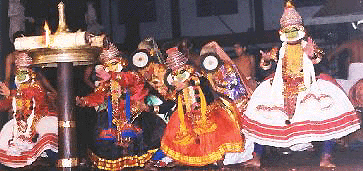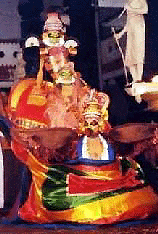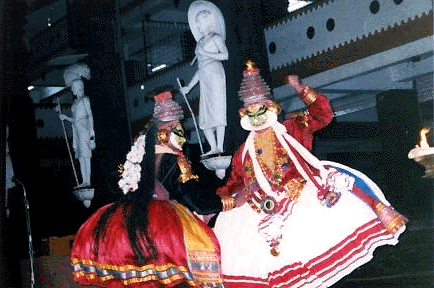
|
|
|
|
BY: SUN STAFF

Avataram - Rohini, Balarama, Yasoda and Krishna Dec 02, CANADA (SUN) — A serial presentation of Krishnanattam dance, a traditional glorification of Sri Krsna's inconceivable pastimes. Krishnanattam (Krishnattam) is a temple art made famous in modern times by devotees at the Guruvayur Temple in Kerala. Reminiscent of the Kathakali style of dance, Krishnanattam is based on a Sanskrit text, Krishnagiti, whose slokas and padams were composed by Manavedan, the Zamorin King of Calicut, in 1654. Through this beautiful and expressive form of dance, Sri Krsna's pastimes are depicted as they are told in the Tenth and Eleventh Cantos of Srimad-Bhagavatam, the Mahabharata, and Harivamsa. These lila pastimes are presented in song, dance and drama in eight plays, performed over the course of eight days. The plays are entitled Avataram, Kaliyamardanam, Rasakrida, Kamsavadham, Swayamvaram, Banayuddham, Vividavadham and Swargarohanam. A popular mnemonic is used to remember their names in proper order: 'Akaraka Swabhaviswa'. Interestingly, Krishnanattam performances are always held at night. This tradition came into being because the Krishnanattam is so sweet and attractive, Sri Krsna Himself has been known to run away from wherever He is, to go and watch the performances. Therefore the dance does not begin until Krsna is sound asleep, so He will not leave his devotees. Every aspect of the Krishnanattam performance is sacred, and there is a great deal of ritual associated even with preparations for its practice and performance. Over the next few days, we will explore this super-excellent vehicle for Sri Krsna's glorification, beginning with excerpts from an overview of Krishnanattam written by A. Harindranath and A. Purushothaman. They begin by describing the preparatory rituals engaged in by the performers, as they prefer to enact Sri Krishnanattam.
Preliminary Rituals "Kelikottu is the first event of the play. Kelikottu is carried out by playing drums (maddalams), gong (chengala) and cymbals (elathalam) in the evening during daytime at the East Nada of the temple. This is to inform the people in the neighborhood about the performance scheduled in the night. A lamp is lit in the makeup room at dusk. Actors (all male) put on their make up, sitting on the floor, around another lamp lighted from the lamp in the makeup room. As soon as the daily rituals of the temple are completed and the Sanctum Sanctorum is closed for the day (about 10 to 10:30 p.m.), the Kali Vilakku (an Oil Lamp of the Play) is kept in front of performance space in the temple on the north side of the Sanctum Sanctorum. The Kali Vilakku is lit by a brahmin from the lamp in the make-up room. Stage hands place the musical instruments (drums, gong and cymbals) on the ground behind the Kali Vilakku. The maddalam players touch them respectfully, lift them up, play a couple of beats on both sides to invoke sabdabrahma, and hang the instruments around their waists. Then Kelikkayyu is performed using maddalams, chengala and elathalam. After kelikkayyu, a colourful rectangular Thirassila (curtain) is held behind Kali Vilakku by two stage hands. Then Todayam is performed behind the screen by the women characters appearing in that day's play. Todayam is a prayer dance performed by the dancers, accompanied by music to invoke the blessings of the Lord. Todayam is not for the spectators. For Todayam, the lines starting with Narayana Narakantaka Narakaparayana in the fifth padam of the play Kaliyamardanam are sung. All performances begin with the recital of the sloka starting with Souvarnatbhuta as the mangala sloka (Auspicious Beginning). After Todayam, it is time for Purappatu, a piece of pure dance choreography. Either Krishna or Balarama or both, sometimes along with other characters, dance with gestures of hand and face and special steps. In Avataram, the first scene (Brahma and Bhumi Devi) is considered as Purappatu. In other plays, the scene in which either Krishna or Balarama or both appear first on stage is considered as Purappatu. In Kamsavadham, Purappatu is in the middle of the play. In Vividavadham, there are two Purappatu, first in the beginning (Balarama and wives) and the other after some time (Krishna, Bhima and Arjuna). In Swargarohanam, there is no Purappatu.

Upananda, Balarama, Krishna and Nandagopa The characters performing Purappatu for the plays are as follows:
Avataram - Brahma and Bhumi Devi Concluding Rituals Except Swargarohanam, all plays end with Dhanasi. The characters in the last scene of the play perform Dhanasi by dancing in a particular way, accompanied by singing the lines starting with Narayana Narakantaka Narakaparayana in the fifth padam of the play Kaliyamardanam. The characters performing Dhanasi for the plays are as follows:
Avataram - Krishna and Yasoda As the characters exit from the stage, a sloka is sung as Mangalam (Auspicious Ending). The characters performing Mangalam for the plays are as follows:
Avataram - Kelilola (last sloka in Avataram) The play is concluded by playing a couple of beats on the maddalam, just as in the beginning.
Some Features of the Performance The actors dance and act behind the Kali Vilakku while the singers sing standing behind - this is the general nature of the play. The lead singer sings, playing the gong, the second singer repeats playing the cymbals. Accompanied by suddha maddalam, toppi maddalam and edakka, both singers sing the slokas and padams of Krishnagiti, one by one, once. Some padams and slokas are sung more than once. For example, slokas starting with Atha tou datha tou, Ghora tara kopa bhara (Swayamvaram), Dharani Ramaniya (Vividavadham). All the slokas and padams of Krishnagiti are not used for the play. By tradition many are omitted. There was a tradition of actors singing along with the singers at three places: One in Kaliyamardanam, pallavam of padam 5, jivitanayaka and two in Rasakrida, pallavam of padam 3, jaya jaya ramaramana and six slokas starting with Padou tou, Vaktram netra, Cillinam jagata, Vani manasaharini, Lavanyam tadavarnaniyam and Sa strinam. These days, the actors do not sing. In the performance space, between the singers and Kali Vilakku, the actors dance and act wearing multicoloured costumes. Dancing and acting in general do not conform to the 'text' being sung, but are according to ragas (tunes) and talas (beats). In Krishnanattam, five types of facial make-ups, Paccha (green), Pazhuppu (orange), Kathi (knife), Minukku and Kari (black) and masks are used. A Paccha facial make-up is used for Krishna, Vasudeva, Kamsa, Nandgopa, Uddhava, Muchukunda, Dandavakthra, Rukmi, Arjuna, Jarasandha, etc.

Garuda, Satyabhama and Krishna A Kathi facial make-up is used for bad but kingly characters (Sankhachuda in Rasakrida, Sisupala in Vividavadham, Bana in Banayudhham). Incidentally, in Swayamvaram, Sisupala appears as Paccha. Pazhuppu is for Balarama, Siva and Bhima. Minukku is for all women, Narada, Sandipani, Yavana, Kucela, etc. There is no facial make-up for Toddy Tapper and Kucela (Vividavadham). For Yasoda, Bhumi Devi, Radha and Satyabhama, green colour is applied on the face and a chutti is provided. In earlier days, Devaki and Rukmini used to have chutti on their face. These were converted to Minukku during the time of A.C.G. Raja. Kari is for Putana (mask - Avataram) and the hunter Jara (Swargarohanam). In some plays, the same actor appears in different roles. For example, in Swayamvaram the same actor appears as Sandipani and Rukmini. The roles of Dhantavakthra and Satrajit are played by the same actor. The roles of Uddhava, Muchukunda, Sisupala and Rukmi are also played by one actor.

Krishna and Sankhachuda
| |